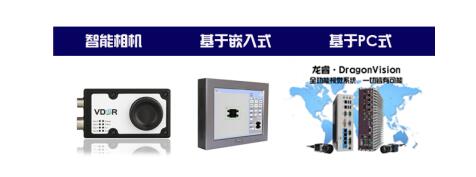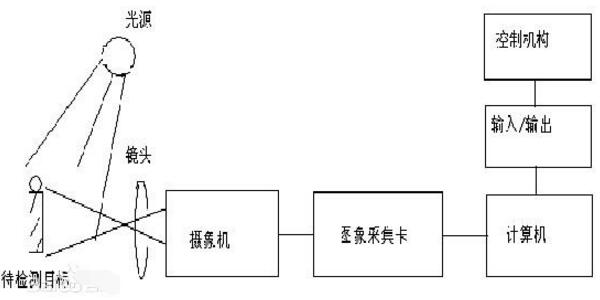Machine vision is a branch of artificial intelligence that is rapidly evolving. Simply put, machine vision is to use the machine instead of the human eye to make measurements and judgments. The machine vision system converts the ingested target into an image signal through machine vision products (ie, image capturing device, divided into CMOS and CCD), and transmits it to a dedicated image processing system to obtain shape information of the target, according to pixel distribution and The information such as brightness and color is converted into a digitized signal; the image system performs various operations on these signals to extract the features of the target, and then controls the action of the device on the basis according to the result of the discrimination.
Classification of machine vision systems•Smart camera
• Based on embedded
• PC based

• Image acquisition: light source, lens, camera, capture card, mechanical platform
• Image processing and analysis: industrial control host, image processing analysis software, graphical interactive interface.
• Judgment execution: telex unit, mechanical unit

The machine vision detection system uses a CCD camera to convert the detected object into an image signal, which is transmitted to a dedicated image processing system, and converted into a digital signal according to pixel distribution, brightness, color, and the like, and the image processing system performs various operations on the signals. To extract the characteristics of the target, such as area, quantity, position, length, and then output the results according to the preset allowable degree and other conditions, including size, angle, number, pass/fail, presence/absence, etc. .

There are two vibrating plates on the scene. The vibrating plate 1 acts to vibrate the doll into the vibrating plate 2. The vibrating plate 2 acts to vibrate the doll from the opposite side to the front. The application adopts Shenzhen Vision Dragon VD200 visual positioning system. By judging the front and back of the doll, the system sends the coordinates of the doll to the front through the serial port to the robot. After the robot receives the coordinates, the motion grabs the product. When there are many vibration disks When the doll is on the reverse side, the VD200 visual positioning system needs to judge the number of opposite dolls. When the number of opposite dolls is too large, the VD200 vision system sends a command to the vibrating tray 2 to vibrate the opposite doll.
The positioning system judges whether the doll is on the front side through the small hole on the surface of the doll, calculates the coordinates of the center point of the doll, and sends it to the robot. The VD200 visual positioning system realizes automatic feeding, which greatly reduces labor costs and greatly improves production efficiency.
Case 2: Application of visual inspection in electronic componentsThis product is the button part of the electronic product. The incoming material is in the strip mode, and the strip is above the double row. After positioning each component, use the spot tool to detect the gray value of the fixed area of ​​the product to determine whether there is any lack of glue in the area.
The application uses Shenzhen Vision Dragon's DragonVision vision system solution, using two cameras and light source with mechanical equipment, to achieve 8 products on both sides of each inspection, about 1500 tests per minute. When the product is defective, it will immediately stop the alarm and ensure the product's pass rate and the normal operation of the equipment, and improve the production efficiency.
Case 3: Case of filling level detection system used by breweryAs each beer bottle moves past the detection sensor, the detection sensor will trigger the vision system to emit a stroboscopic light and take a picture of the beer bottle. After capturing the image of the beer bottle and saving the image to memory, the vision software will process or analyze the image and issue a pass-fail response based on the actual fill level of the beer bottle. If the vision system detects that a beer bottle is not filled, ie, fails the test, the vision system will signal the diverter to remove the beer bottle from the production line. The operator can view the rejected beer bottles and ongoing process statistics on the display.
Application status of machine visionIn foreign countries, the popularity of machine vision is mainly reflected in the semiconductor and electronics industries, of which about 40%-50% are concentrated in the semiconductor industry. Specifically, such as PCB printed circuit: various types of printed circuit board assembly technology and equipment; single, double-sided, multi-layer circuit boards, copper clad laminates and required materials and accessories; auxiliary facilities and consumables, inks, syrups, accessories; Packaging technology and equipment; screen printing equipment and wire mesh peripheral materials. SMT surface mount: SMT process and equipment, welding equipment, test equipment, rework equipment and various auxiliary tools and accessories, SMT materials, stickers, adhesives, flux, solder and anti-oxidation oil, solder paste, cleaning agents, etc.; Reflow soldering machine, wave soldering machine and automatic production line equipment. Electronic production and processing equipment: electronic component manufacturing equipment, semiconductor and integrated circuit manufacturing equipment, component molding equipment, electronic tooling. Machine vision systems have also been widely used in all aspects of quality inspection, and their products occupy a pivotal position in applications. In addition, machine vision is used in a variety of other fields.
In China, the application of visual technology began in the 1990s, because the industry itself is an emerging field, coupled with the lack of popularization of machine vision product technology, resulting in almost blank applications in the above industries. At present, domestic machine vision is mostly foreign brands. Most of the domestic machine vision companies basically rely on foreign machine vision brands to start, with the continuous application of machine vision, the company's scale is slowly growing, the technology has gradually matured.
As the economic level improves, 3D machine vision has also begun to enter people's field of vision. 3D machine vision is mostly used for the ratings of fruits and vegetables, wood, cosmetics, baked goods, electronic components and pharmaceutical products. It can increase the production capacity of qualified products and scrap the inferior products early in the production process, thus reducing waste and saving costs. This feature is ideal for imaging product attributes such as height, shape, quantity, and even color.
In the industry applications, mainly in the pharmaceutical, packaging, electronics, automotive, semiconductor, textile, tobacco, transportation, logistics and other industries, the use of machine vision technology to replace labor, can provide production efficiency and product quality. For example, in the logistics industry, machine vision technology can be used for sorting and sorting of express delivery. There is no manual sorting by most courier companies to reduce the damage rate of articles, which can improve sorting efficiency and reduce manual labor.
Watch & Apple Airtag Screen Protector
TPU Watch Screen Protector, Transparent ​Watch Screen Protector, Watch Screen Protector Case, Apple Watch Case, Apple Watch Case Protector, Apple Watch Protective Case
Shenzhen Jianjiantong Technology Co., Ltd. , https://www.jjtscreenprotector.com